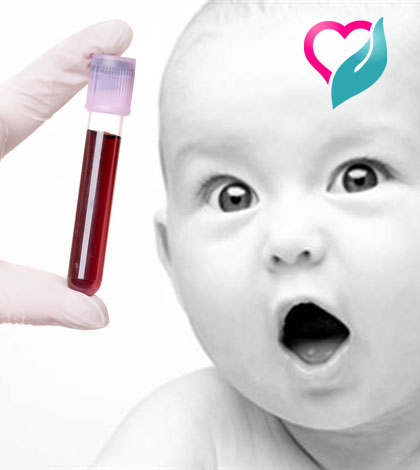The discovery of blood groups by Dr. Karl Landsteiner made it possible to determine a person’s blood group based on a characteristic of specific substances on the surface of red blood cells.
[wp_ad_camp_1]
The two most important classifications to describe blood groups in humans are ABO and the Rhesus factor (Rh factor). Knowledge of one’s blood group is important for medical reasons. In case of blood transfusion, it is critical that a person gets the same or compatible blood type.
When describing the blood type, the Rh +ve or -ve is written as O+ve or AB+ve or O-ve or AB-ve. The Rh type is especially important in pregnancy because, Rh incompatibility that happens when the mother’s blood group is Rh negative and her fetus’ blood group is Rh positive, can harm the fetus and cause pregnancy complications.
[wp_ad_camp_4]
Blood Type & Paternity Determination
The ABO blood type charts below can be used to predict the possibilities of paternity.
It helps to determine either:
The ABO blood type of the child when the blood type of the father and the mother are known (top chart), or
The ABO blood type of the father if the blood type of the child and the mother are known (bottom chart).
On the flip side, both ABO and Rh blood systems for determination of paternity are not conclusive and at best can only be predictive. Blood grouping can be flawed due to mutations and give false conclusions and for these reasons we caution all readers to view this calculator only as a predictive tool. So if your child’s blood group does not match up please do not suspect your partner. If you require further evidence of paternity, we suggest you contact an accredited medical diagnostic lab.
ABO blood types can be complicated to understand. This is mostly due to the fact that the ‘O-type’ antigen is masked by the presence of an A- or B-type antigen. This is explained in the following chart, showing the different the genotypes that make up the blood types.
Genotype (DNA) Blood Type
AO or AA A blood type
AB AB blood type
BO or BB B blood type
OO O blood type
For example, two O blood type parents can produce a child with only O blood type. Two parents with A blood type can produce a child with either A or O blood types. Two parents with B blood type can produce a child with either B or O blood type. One parent with A and another with B can produce a child with A, B, AB or O blood types. If one parent has A and another has AB, they can either produce a child with A, B or AB blood types. If one parent has A and another has O, they can either produce a child with A or O blood types.
Rh Positive & Negative Blood Types
The Rh (+/-) factor is inherited separately from the ABO blood types. Similarly to the masking effect of the O gene in ABO blood types, the Rh negative (Rh-) gene is also masked by the presence of an Rh positive (Rh+) genotype. Therefore, a person may have an Rh + blood type and can still have an Rh negative gene. Furthermore, two parents with Rh + blood types can have a child with Rh – blood type.
Blood Group Diet
Blood group diet is a beneficial diet plan that is gaining popularity worldwide. If you are planning on losing weight and looking for some diet plans, blood group diet may come in handy. This diet, invented by Dr. Peter D’Adamo, helps to reduce weight. He suggests the diets that can be followed by an individual as per his blood group.
The chemical reaction to digest the food begins soon after the ingestion of the food. This reaction takes place between lectin (the sugar-binding proteins) present in the food and the blood. This reaction has direct effect on body organs. However, all lectins are not hazardous – their function depends on the compatibility with your blood antigen. Incompatible lectins react with your blood and cause health problems.
Despite the fact that the blood types of children are solely determined by inheritance from their parents, paternity can no longer be legally established based on conventional blood typing. To do that, it is necessary to compare HLA types and/or DNA sequences. The use of DNA is more accurate in determining paternity, but it is also more expensive than HLA typing.
Antibodies to alien antigens in the ABO group are usually present in our plasma prior to the first contact with blood of a different ABO type. This may be partly explained by the fact that these antigens are also produced by certain bacteria and possibly some plants. When we come in contact with them, our bodies may develop long-term active immunity to their antigens and subsequently to the same antigens on the surface of red blood cells. This usually occurs in babies within the first six months following their birth.
Environmental Factors
While blood types are 100% genetically inherited, the environment potentially can determine which blood types in a population will be passed on more frequently to the next generation. It does this through natural selection. Specific ABO blood types are thought to be linked with increased or decreased susceptibility to particular diseases. For instance, individuals with type A blood are at a somewhat higher risk of contracting smallpox and developing cancer of the esophagus, pancreas, and stomach. People who are type O are at a higher risk for contracting cholera and plague as well as developing duodenal and peptic ulcers. Research suggests that they are also more tasty to mosquitoes. That could be a significant factor in contracting malaria.
The ABO blood type chart
The blood group diet chart
[wp_ad_camp_3]
Image courtesy: nbcnews.com , answers.com





























